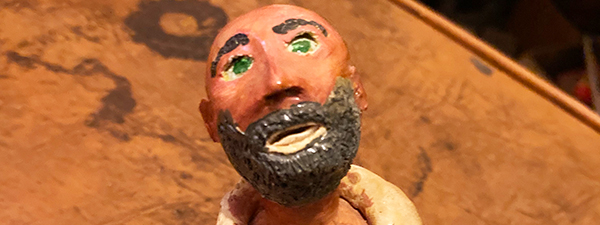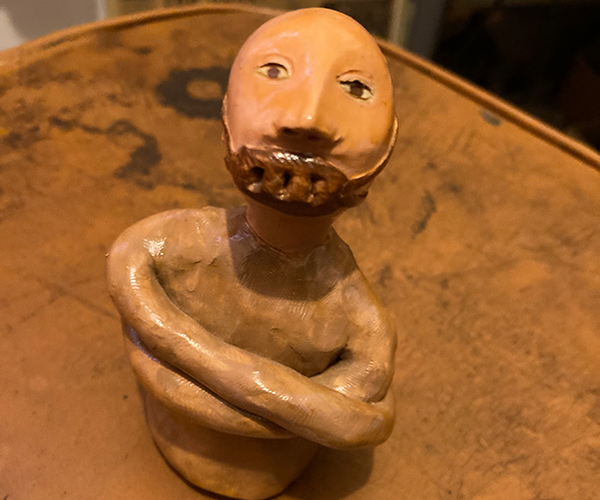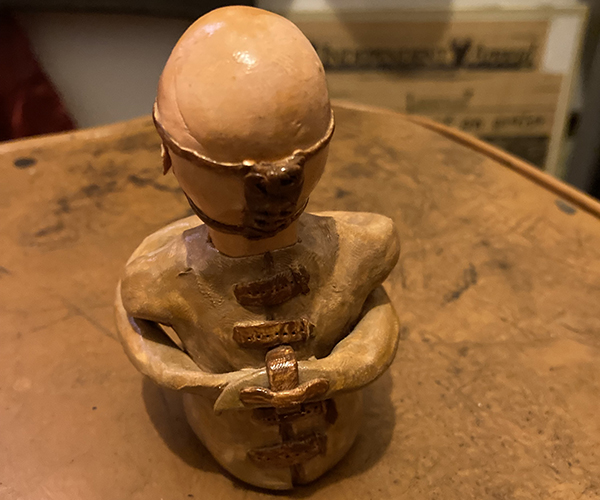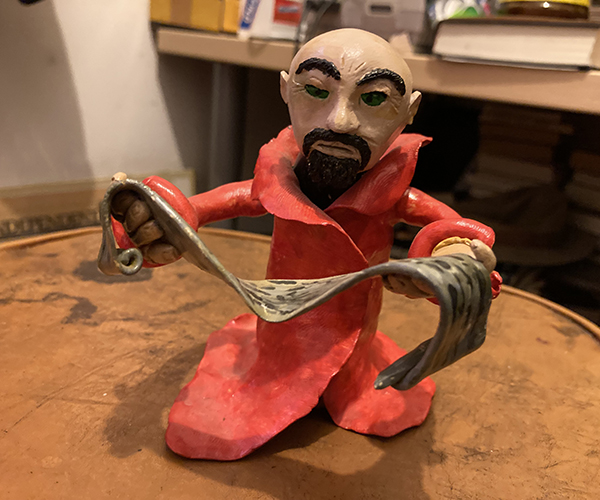
A SELF-TAUGHT ARTIST WHOSE LIFE WAS HARD LEAVES A CURIOUS LEGACY FOR HIS NEWSPAPER-REPORTER SON TO FIGURE OUT
by Edward M. Gómez
It’s often among producers of artworks that never make it to — or, more precisely, that are never really intended for — any established art market that many an art-maker with an interesting personal story and some clever or curious concoctions may be found. Check out the annals of American folk art, outsider art, and art brut in general for many a tale and for countless, intriguing examples of such creators.
As this issue of brutjournal was being assembled, Gregory Pratt, a City Hall reporter for the Chicago Tribune, brought to our attention a body of clay figurines his late father, Gregory Royal Pratt, who recently died at the age of 54, had produced over a period of about 15 years. The older Pratt stopped making the small objects, using the oven-baked version of Sculpey, a popular polymer modeling clay, around the year 2005. By that time, his now 32-year-old son told us, the self-taught sculptor had produced as many as 500 statuettes representing such characters as a priest, a man in a straitjacket, a satanic wizard, and a flasher.

“One figure,” the younger Gregory told us, “a guy with a bandana, feels like a self-portrait of my father, while another one appears to be a wise man.”
advertisement

It’s always somewhat risky — and something of a lazy cop-out — to psychoanalyze the maker of works of art solely or primarily via his or her creations. Still, as Gregory Pratt has noted, his father’s artistic legacy, which has now surfaced, and about which he would like to know more, might offer some clues to understanding the experiences and outlook of their maker, a man, his son recalled, whose life was filled with hardship and pain.
The younger Gregory was brought up by his Mexican-born mother in southwestern Chicago’s Little Village district, the home of many immigrants from Mexico. When he was five years old, his father left the family. As Gregory recalled, “He said he was running away from Italians to whom he owed money and from a drug problem he couldn’t escape. My parents tried to make it work but couldn’t.” Gregory Royal Pratt made his way to Tennessee, where, in time, he married again, kept a vegetable garden, and for many years worked in a refrigerator-manufacturing factory.

In a recent, short article in the Chicago Tribune, the late self-taught artist’s son wrote, “My dad lived with deep addiction. It led him to [make] poor decisions and [to] prison […].” He noted, “Despite his problems, my dad tried repeatedly to get sober and for stretches of time succeeded. But he couldn’t beat the disease. He once wrote in an e-mail to me: ‘Too many demons in my past, and the more I fight them, the more they fight me.’ So he kept his distance from Chicago and his only child.”
Apparently, Gregory Royal Pratt began making his clay figurines sometime after relocating to Tennessee; at least Gregory, Jr.’s mother does not recall seeing him produce the little objects during the period when the young family lived together in Chicago. The self-taught artist’s son told us that, as a hobby, his father had made birdhouses and at one point went to school to study drafting “to help him with his work, for, at the refrigerator factory, he had to program a machine for sheet metal, which meant that he had to be familiar with basic geometry.”

Piecing together details of his late father’s life, the younger Pratt learned from relatives that, “during the earlier period of his life, he had a den in his house with a steel patio table indoors.”
There, Gregory noted, “He would drink vodka, smoke cheap cigarettes, and work on the figures while the TV was on in the background. Eventually, he got a desk. Later, in the 1990s or early 2000s, when he moved in with his second wife, Desiree, they set up his hobby room, in which he had knives and swords, among other tools.”
In 2003, Gregory Royal Pratt enjoyed a fleeting moment in a small spotlight when a local newspaper in Tennessee published an item about him. About his hand-crafted figurines, he told its reporter, “If they don’t talk to me, I set them on the side.”

With their large hands and heads, spindly arms, and exaggerated facial features — including big, expressive eyes and eyebrows — the older Pratt’s small sculptures bring to mind three-dimensional versions of comic-book characters or perhaps an inventive costume designer’s novel way of presenting a group of sketches. Their jackets and coats are skillfully rendered in thin sheets of rolled, shaped clay. It appears that the artist painted his figures after they had been oven-baked. His straitjacketed man also appears to wear a muzzle; his eyes gaze out at a viewer with a sense of liveliness belying the confinement of his contorted torso. The artist’s wise men support themselves with walking sticks, while his flasher displays a generous endowment that surely would earn him a legion of OnlyFans admirers.
For now, Gregory, Jr. continues to collect anecdotes and information about a father who was never fully present in his life but who left a curious artistic legacy that has quickly come to fascinate him.
He noted, “Interestingly, I’m told that my dad was once invited to an arts-and-crafts fair in his town but that he refused to go, for he felt that a lot of the other art [that was on view there] was not really art. For instance, he would complain if someone made a dress for a doll, put it on an already-made doll, and called it art. ‘He didn’t want to be next to them,’ Desiree told me. ‘He said, ‘They don’t know what art is. You make something out of nothing. That’s art.’”




